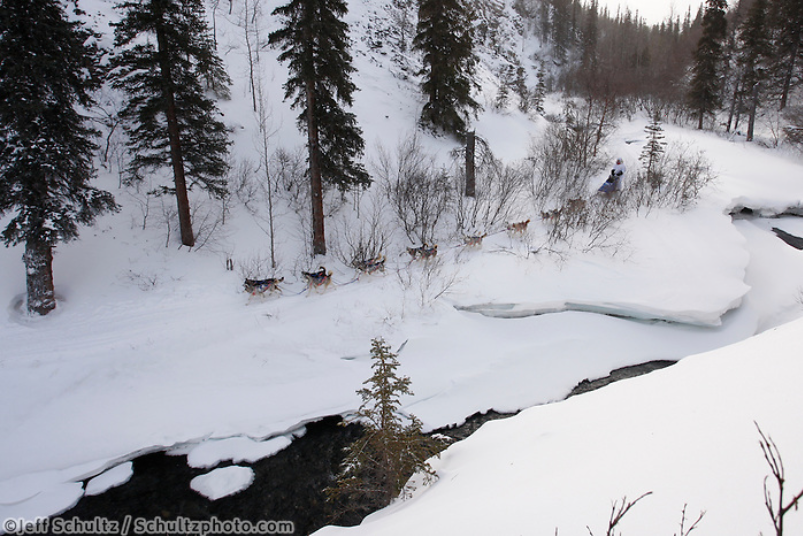Iditarod 2020 - March 9th
Episode 2 -- Yentna to Rohn
By Michael Rogers
Morning came to the Iditarod trail as Richie Diehl became the first to arrive in Finger Lake at 6:50am. He was soon passed by other teams and they fought to become one of the first to make it to the Happy River Steps.

Photo by Jeff Schultz
Overnight, most of the teams made the journey from Yentna, through Skwentna to Finger Lake. Outside of Skwentna the snow tapered off into a good trail and the front pack made good time getting to Finger Lake. Most of the teams pushed onward toward the dreaded Happy River Steps. The Steps have ended numerous musher’s attempts at the Iditarod and on icy years have been the scene of some dramatic pile ups. The Steps are required to move down from the bench above Finger Lake onto Happy River itself. In an interview today in Rainy Pass with 4-time winner Lance Mackey, he described the Steps as “boring” with ample snow cover this year to grab the snow hook. That will be true for the first teams, but each successive team will erode the trail a bit more. As night fell, about half the teams were behind the Steps and will have to descend it in the dark. If the snow holds out, it won’t be significant. Otherwise, it can end a race. An early lead pack has formed with defending champ Pete Kaiser who arrived in Rainy Pass first followed closely by Travis Beals, Lance Mackey, and Richie Diehl. They spent about 4 hours in Rainy Pass and after Burmeister and Sass arrived late afternoon they left and chased them down the Dalzell Gorge.

The Gorge is a pass through the Alaska Range that can be a challenging section of trail with rough terrain and strong headwinds. For the first teams, deep wind packed snow should be relatively easy this year IDITAROD 2020 1 aided by a bright “super moon” if the clouds pull back. At the end of the Gorge is Rohn, the gateway to the Interior. At this writing, Aaron Burmeister, Richie Diehl, Travis Beals, Lance Mackey, Wade Marrs and Pete Kaiser are all in Rohn. One of the consistently poor sections of trail awaits them when they depart for Nikolai.

Photo by Jeff Schultz
Lance Mackey is proving he can still run with the best of them despite a string of health issues over the last few years. Mackey won the Iditarod four times in the 2000s as well as four Yukon Quests back to back, a feat that many believe won’t happen again. He ran the 2019 race in a relaxed manner and finished 26 th having a blast the whole way. 2020 seems to be a different race and he is keeping up with Kaiser. I wouldn’t discount Mackey until he has a headstone with two dates.

He’s part of the lead pack that is about 10- 15 miles ahead of some of the best mushers in the world. As the race enters the Interior, it will be interesting to see what the weather and unusually deep snow does for the teams. The infamous Farewell Burn is completely snow covered for a change and should be an improvement over the bare tussocks and standing trunks normally associated with the area.

Aerial of two mushers along the scantly snowcovered trail in the Farewell Burn area between Rohn & Nickolai in previous Iditarod. Photo by Jeff Schultz
I would anticipate an uneventful run into Nikolai except for moose and the bison that inhabit the area. The teams are relatively tight, stretched over the 65 miles from Finger Lake to Rohn. Most years see quite a bit more separation by the end of Day 2, probably a direct result of the slower paces in the deep snow out of Willow.


